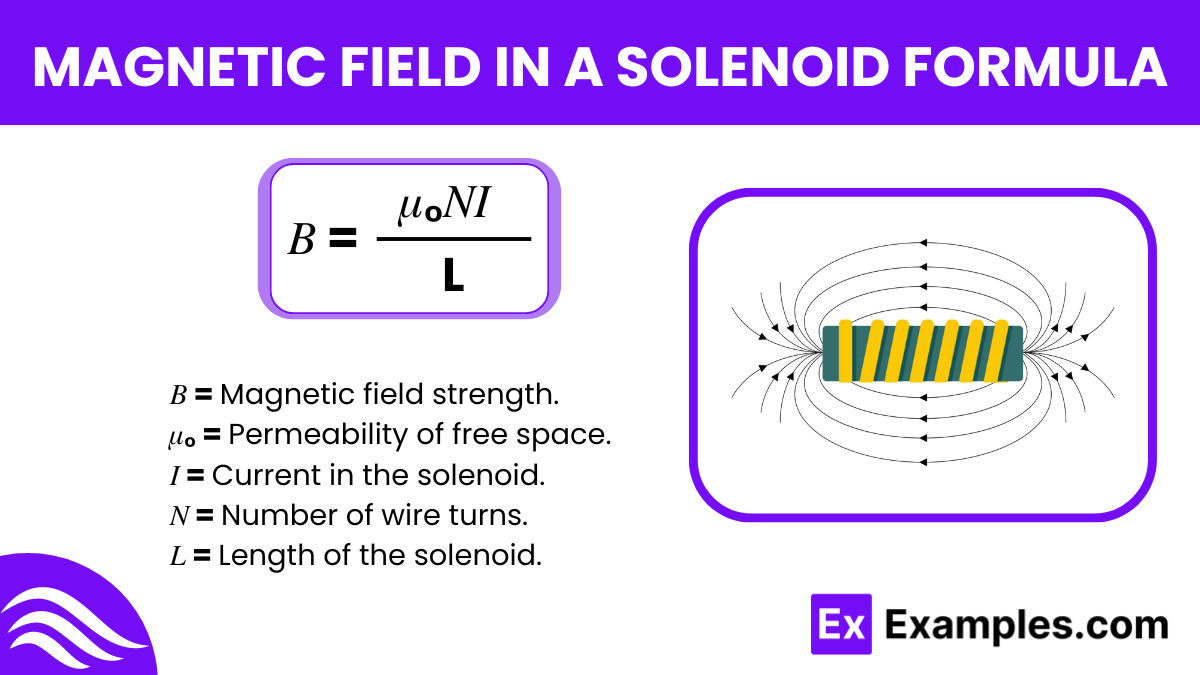What does μ₀ represent in the solenoid formula?
Magnetic permeability of the solenoid material
Magnetic permeability of free space
Electric constant
Current through the solenoid


The formula for the magnetic field inside a solenoid is essential in physics for calculating the field strength. The formula is represented as :
This formula allows us to understand how changes in the solenoid’s current, the number of coils, or its length affect the magnetic field strength inside it. This formula was advanced by André-Marie Ampère, a pioneer in the study of electromagnetism. His research laid the groundwork for linking magnetic fields to the electric currents that generate them, culminating in the direct application of Ampère’s law.
To derive the formula for the magnetic field inside a solenoid, we start with Ampère’s Law, which states:
We select a rectangular Amperian loop that runs parallel to the solenoid’s axis inside and completes the rectangle outside where the magnetic field is negligible. Here, 𝐼ₑₙ꜀ represents the total current enclosed by the loop. If 𝐼 is the current in each turn of the solenoid and there are 𝑁 turns over the length 𝐿, with 𝑛 = 𝑁 / 𝐿 being the turns per unit length, then:
Applying Ampère’s Law, only the segment inside the solenoid contributes to the magnetic field, simplifying the integral to:
Thus, the magnetic field 𝐵B inside the solenoid simplifies to:
Question: A solenoid has a length of 50 cm, contains 200 turns, and a current of 2 A flows through it. Calculate the magnetic field inside the solenoid. Assume the permeability of free space, 𝜇ₒ, is 4𝜋×10⁻⁷ 𝑇⋅𝑚/𝐴.
Solution:
Convert length from cm to meters: 𝐿=0.50 𝑚
Use the formula 𝐵 = 𝜇ₒ𝐼𝑁 / 𝐿
Substitute the values:
𝐵 = ( (4𝜋×10⁻⁷ 𝑇⋅𝑚/𝐴)(2 𝐴)(200) ) / 0.50 𝑚= ( 502.654 × 10⁻⁴ 𝑇) / 0.50 𝑚
Calculate:𝐵=0.2007 𝑇
Answer: The magnetic field inside the solenoid is 0.2007 𝑇.
Question: Using the same solenoid from Problem 1, what would the magnetic field be if the current is increased to 5 A?
Solution:
Use the same length, number of turns, and 𝜇ₒ from Problem 1.
Substitute the new current into the formula:
𝐵 = ( (4𝜋 × 10⁻⁷ 𝑇⋅𝑚/𝐴) (5 𝐴) (200) ) / 0.50 𝑚= ( 1256.637 × 10⁻⁴ 𝑇) / 0.50 𝑚
Calculate:𝐵=0.5027 𝑇
Answer: The Magnetic field is now 0.5027 𝑇.
Question: If the number of turns in the solenoid from Problem 1 is increased to 400 turns while keeping the current at 2 A, what is the new magnetic field?
Solution:
Keep the length and 𝜇ₒ constant.
Substitute the new number of turns into the formula:
𝐵 = ( (4𝜋 × 10⁻⁷ 𝑇⋅𝑚/𝐴) (2 𝐴) (400) ) / 0.50 𝑚 = (1005.31 × 10⁻⁴ 𝑇) /0.50 𝑚
Answer: The Magnetic field inside the solenoid is 0.4011 𝑇.
The Magnetic field inside a solenoid is uniform and parallel to its axis, following the right-hand rule for current direction.
The Magnetic moment (𝜇) of a solenoid is calculated by 𝜇=𝑁𝐼𝐴, where 𝑁 is turns, 𝐼 is current, and 𝐴 is area.
A coil’s Magnetic field circles the wire, determined by the right-hand rule, where thumb direction indicates current and fingers show field lines.
Text prompt
Add Tone
10 Examples of Public speaking
20 Examples of Gas lighting
What does μ₀ represent in the solenoid formula?
Magnetic permeability of the solenoid material
Magnetic permeability of free space
Electric constant
Current through the solenoid
What is the formula for the magnetic field inside an ideal solenoid?
B = μ₀nI
B = μ₀IR
B = μ₀I²
B = μ₀nR
In a solenoid, what does the term 'n' represent in the formula B = μ₀nI?
Current
Number of turns
Number of turns per unit length
Magnetic permeability
If the current in a solenoid is doubled, what happens to the magnetic field inside the solenoid?
It remains the same
It is halved
It doubles
It becomes zero
Which of the following will increase the magnetic field inside a solenoid?
Decreasing the number of turns per unit length
Increasing the current
Decreasing the current
Using a shorter solenoid
What happens to the magnetic field inside a solenoid if the number of turns per unit length is increased?
It decreases
It remains the same
It increases
It becomes zero
Which factor does not affect the magnetic field inside an ideal solenoid?
Length of the solenoid
Current through the solenoid
Number of turns per unit length
Permeability of free space
How does the magnetic field inside a solenoid change if the permeability of the core material increases?
It decreases
It remains the same
It increases
It becomes zero
What is the unit of the magnetic field (B) in the SI system?
Tesla
Weber
Ampere
Ohm
In the formula B = μ₀nI, what does μ₀ represent?
Magnetic permeability of the core
Permeability of free space
Number of turns per unit length
Magnetic flux
Before you leave, take our quick quiz to enhance your learning!

